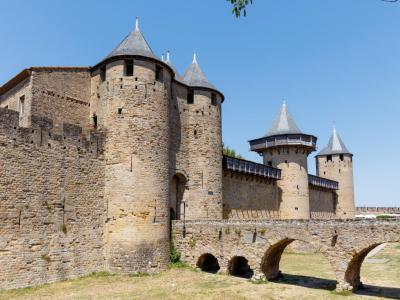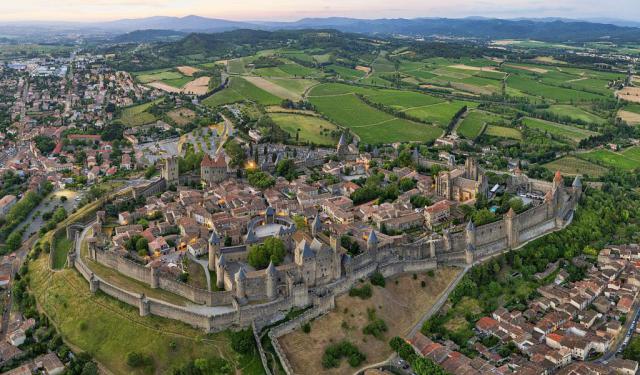
Château et Remparts (Castle and Ramparts), Carcassonne (must see)
Carcassonne is two cities. The Cite is the medieval fortress city. The city outside the walls, the lower city dates from 1209, when the Cathar citizens of the cite were evicted in Albigensian Crusade. They settled below the walls.
The fortified city is enclosed within two concentric rings of stone walls. There are 53 towers and barbicans designed to frustrate attacks by siege engines. The castle is protected by a dry moat and drawbridge connecting to the Keep or donjon in the center.
The towers in the walls were built over a long period. The Roman style towers have sloped roofs of terra-cotta tiles. The others are topped with Gothic pointed blue slate roofs. One of the towers is known as the "Inquisition Tower." It was used as a prison and torture center by the Catholic Church in the 13th century.
In 1853 restoration work began on the west and southwest walls. The towers of the Porte Narbonnaise and the entrance to the Cite followed. Most of the work was focused on the tower roofing and the ramparts. Restoration was carried out mostly by Eugene Viollet-le-Duc. He was criticized for mixing styles but his achievement is extraordinary.
The fortified city is enclosed within two concentric rings of stone walls. There are 53 towers and barbicans designed to frustrate attacks by siege engines. The castle is protected by a dry moat and drawbridge connecting to the Keep or donjon in the center.
The towers in the walls were built over a long period. The Roman style towers have sloped roofs of terra-cotta tiles. The others are topped with Gothic pointed blue slate roofs. One of the towers is known as the "Inquisition Tower." It was used as a prison and torture center by the Catholic Church in the 13th century.
In 1853 restoration work began on the west and southwest walls. The towers of the Porte Narbonnaise and the entrance to the Cite followed. Most of the work was focused on the tower roofing and the ramparts. Restoration was carried out mostly by Eugene Viollet-le-Duc. He was criticized for mixing styles but his achievement is extraordinary.
Want to visit this sight? Check out these Self-Guided Walking Tours in Carcassonne. Alternatively, you can download the mobile app "GPSmyCity: Walks in 1K+ Cities" from Apple App Store or Google Play Store. The app turns your mobile device to a personal tour guide and it works offline, so no data plan is needed when traveling abroad.
Château et Remparts (Castle and Ramparts) on Map
Sight Name: Château et Remparts (Castle and Ramparts)
Sight Location: Carcassonne, France (See walking tours in Carcassonne)
Sight Type: Attraction/Landmark
Guide(s) Containing This Sight:
Sight Location: Carcassonne, France (See walking tours in Carcassonne)
Sight Type: Attraction/Landmark
Guide(s) Containing This Sight:
Walking Tours in Carcassonne, France
Create Your Own Walk in Carcassonne
Creating your own self-guided walk in Carcassonne is easy and fun. Choose the city attractions that you want to see and a walk route map will be created just for you. You can even set your hotel as the start point of the walk.
Medieval City of Carcassonne Walking Tour
A pig full of wheat was thrown off the battlements. The lady commanding the fortress was a Muslim. The besieging Christians knew Muslims do not eat pig. What is more, the defenders must have plenty of food if they could feed wheat to a pig and throw it over the walls. The siege had lasted five years. The attackers were starving. They left.
Many stories are told about the fortified medieval... view more
Tour Duration: 1 Hour(s)
Travel Distance: 1.2 Km or 0.7 Miles
Many stories are told about the fortified medieval... view more
Tour Duration: 1 Hour(s)
Travel Distance: 1.2 Km or 0.7 Miles
Carcassonne Introduction Walking Tour
Nestled in the picturesque region of Occitanie in southern France is the captivating city of Carcassonne.
The name "Carcassonne" is believed to have originated from the Gallic word "Carsac," referring to a fort settlement that was later fortified by the Romans who occupied the area in the 1st century BC.
A legend suggests another, more colorful version of the name,... view more
Tour Duration: 2 Hour(s)
Travel Distance: 2.5 Km or 1.6 Miles
The name "Carcassonne" is believed to have originated from the Gallic word "Carsac," referring to a fort settlement that was later fortified by the Romans who occupied the area in the 1st century BC.
A legend suggests another, more colorful version of the name,... view more
Tour Duration: 2 Hour(s)
Travel Distance: 2.5 Km or 1.6 Miles


